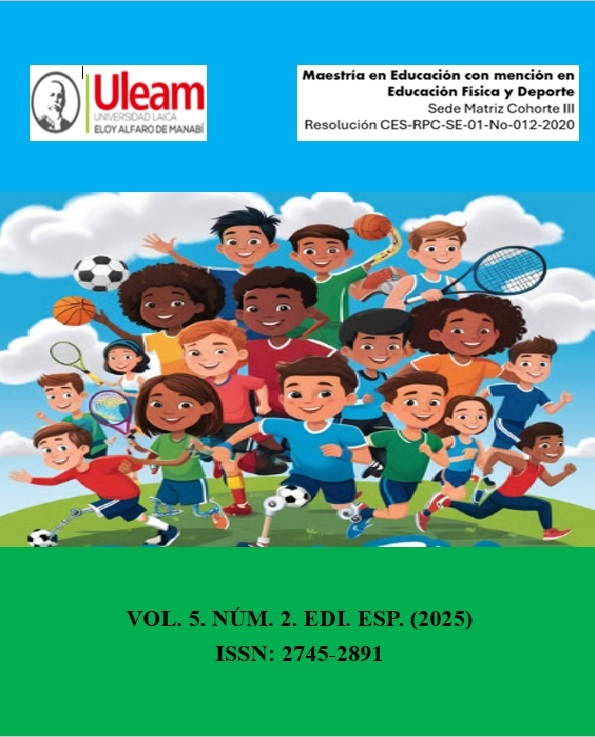Innovative and effective strategies for promoting physical activity and reducing sedentary lifestyle in high school
Abstract
Sedentary lifestyle among high school adolescents, a growing public health concern, negatively impacts physical and cognitive well-being, leading to decreased participation and disinterest in physical education classes. To analyze the impact of innovative strategies in promoting physical activity and reducing sedentary behavior, this research, framed within the "Education and New Scenarios for Professional Training" research line of Universidad Laica Eloy Alfaro de Manabí, utilized a quantitative approach and a descriptive sequential design. The total population and sample consisted of 101 high school students (15-18 years old). The International Physical Activity Questionnaire (IPAQ) was used to diagnose physical activity levels, and a structured observation guide assessed interaction and the impact of 18 didactic strategies. IPAQ results indicated that a large portion of the population is insufficiently active, with an average of 304 minutes of daily physical inactivity. However, the observation guide revealed high effectiveness of the strategies, with 74.44% of observations in "Always" and "Almost always" categories, highlighting active time usage, social interaction, inclusivity, and attitudinal changes. The main conclusion is that innovative strategies are effective, although continued attention to motivation and understanding of benefits is needed for more uniform impact.
Downloads
References
Anguera, M. T., Portell, M., Chacón-Moscoso, S., & Sanduvete-Chaves, S. (2020). Indagación observacional en el ámbito educativo: fundamentos y aplicaciones. Revista de Psicodidáctica, 25(1), 1–8. https://doi.org/10.1016/j.psicod.2019.10.001
Blázquez Sánchez, D. (2017). La educación física en la educación secundaria obligatoria: Perspectivas actuales. Inde Publicaciones, Madrid.
Blázquez Sánchez, M. (2017). Innovaciones tecnológicas en la educación física: Impacto y estrategias. Editorial Universitaria.
Craig, C. L., Marshall, A. L., Sjöström, M., Bauman, A. E., Booth, M. L., Ainsworth, B. E., ... & Oja, P. (2003). International physical activity questionnaire: 12-country reliability and validity. Medicine and Science in Sports and Exercise, 35(8), 1381-1395. https://doi.org/10.1249/01.MSS.0000078924.61453.FB
Creswell, J. W., & Plano Clark, V. L. (2018). Diseño y desarrollo de estudios de investigación mixtos (2.ª ed.). Pearson Educación.
Creswell, J. W. (2014). Research design: Qualitative, quantitative, and mixed methods approaches (4th ed.). SAGE Publications.
García, R. (2023). El juego como herramienta didáctica en Educación Física. Editorial Lúdica Sport.
García-Hermoso, A., Martínez-Vizcaíno, V., & Sánchez-López, M. (2021). Promoción de la actividad física en adolescentes: Programas y enfoques. Revista de investigación en educación física, 34(2), 43-58.
Gómez, J., Fernández, A., & Morales, P. (2020). Sedentarismo juvenil y sus implicaciones en la salud física.
Hernández-Sampieri, R., & Mendoza, C. (2018). Metodología de la investigación: Las rutas cuantitativa, cualitativa y mixta (3.ª ed.). McGraw-Hill.
Hernández, A., Martínez, M., & Gómez, R. (2019). El sedentarismo y sus implicaciones en la educación física escolar. Revista de salud adolescente, 14(2), 45-60.
Johnson, D. W., & Johnson, R. T. (2018). Cooperation in the Classroom. Interaction Book Company.
Ley Orgánica para la Mejora de la Calidad Educativa (LOMCE). (2013). Normativa educativa. Ministerio de Educación.
López-Gil, J. F., Brazo-Sayavera, J., García-Hermoso, A., et al. (2022). Comportamiento sedentario, actividad física y rendimiento académico en niños y adolescentes: una revisión sistemática. Revista Internacional de Investigación Ambiental y Salud Pública, 19(7), 4080.
López, M., & Fernández, S. (2024). Tecnología y Educación Física: Innovando el aprendizaje motor. Revista de Didáctica de la Educación Física, 5(1), 45-60.
López-Gil, M., González, J., & Pérez, A. (2022). Innovación en la educación física: Nuevas metodologías y su impacto. Innovación Educativa Trimestral, 15(2), 116-130.
Martínez, M. (2020). Técnicas de muestreo para investigaciones sociales. Editorial Académica Española.
López, M., & Fernández, S. (2024). Tecnología y Educación Física: Innovando el aprendizaje motor. Revista de Didáctica de la Educación Física, 5(1), 45-60.
Martínez, I. (2021). Motivación y recompensas en la educación física. Revista de Educación Deportiva, 29(1), 50-60.
Méndez-Giménez, A. (2018). Educación Física y Juegos Deportivos: Nuevas Perspectivas Didácticas. Editorial CCS.
Mosston, M., & Ashworth, S. (2008). Teaching Physical Education (6th ed.). Pearson Education.
Organización Mundial de la Salud (OMS). (2020). Informe sobre la inactividad física.
Pérez, L., & Martínez, J. (2022). Educación física y estrategias innovadoras: Adaptación y resultados. Revista Internacional de Educación Física, 18(2), 90-101.
Ruiz-Correa, A., Delgado, F., & González, E. (2020). Gamificación y actividades lúdicas en educación física. Revista de Juegos Educativos, 22(1), 60-75.
Ryan, R. M., & Deci, E. L. (2000). Teoría de la autodeterminación y la facilitación de la motivación intrínseca, el desarrollo social y el bienestar. Psicólogo estadounidense, 55(1), 68-78.
Sánchez, R., Rodríguez, J., & Morales, T. (2018). Gamificación en educación física: Estrategias y resultados. Revista de Deporte y Educación, 21(4), 100-115.
Copyright (c) 2025 Jaime Alexander Guanoluisa Robalino,Giorver Pérez Iribar

This work is licensed under a Creative Commons Attribution-NonCommercial-NoDerivatives 4.0 International License.






